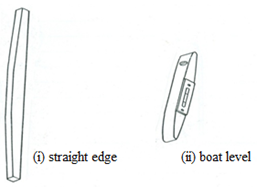Question 2
(a) Sketch each of the following bricklayer’s tools:
(i) straight edge;
(ii) boat level.
(b) State one use of each of the tools sketched in 2(a) above
(c) State three reasons for ensuring safety on a construction site.
(d) Name one safety wear that should be worn on site when carrying a sandcrete
block.
Observation
Most candidates were able to:
- sketch straight edge and boat level;
- Name one safety wear that should be worn on site when carrying a sandcrete block.
However, some of them were unable to:
- state one use of straight edge and boat level;
- state three reasons for ensuring safety on a construction site.
The expected response to question 2 is as given below

(b) Uses of each of the tools:
- Straight-edge is used for:
- checking the flatness of a newly laid wall;
- ensuring that all blocks/bricks are laid to the same level in each course;
- tamping concrete in solid ground floor or reinforced concrete upper floor construction;
- transferring levels in conjunction with the spirit level during setting-out operation;
- adjusting/aligning brick/blockwall vertically and horizontally;
- checking plumb of a wall in conjunction with a spirit level.
- Boat level is used for:
- adjusting small works in a confined space;
- adjusting individual brick or block in a wall;
- checking the flatness of tiles in a tiling work;
- establishing horizontal surface;
- establishing verticality of walls in conjunction with a straight-edge.
(c) Reasons for ensuring safety on a construction site are to:
- avoid injury to operatives;
- safeguard lives of workers;
- avoid waste of man-hour;
- avoid waste of materials;
- avoid additional cost of construction;
- avoid delay of construction;
- boost the moral of workers
- prevent accident on site.
(d) Safety wears to be worn when carrying a concrete block include:
- hand gloves; rubber gloves; leather gloves etc;
- hard boots;
- overall;
- helmet;
- visor.
